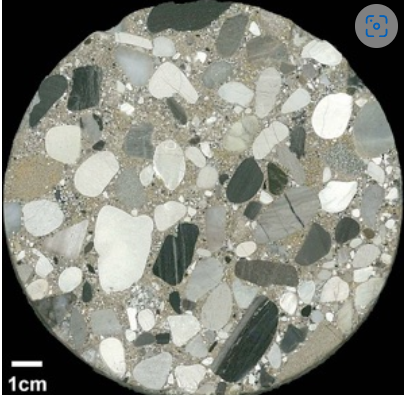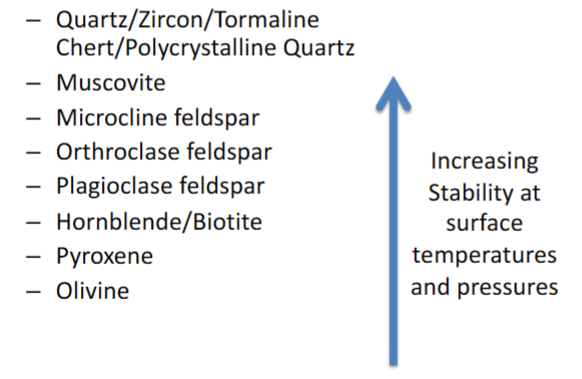Clastic sedimentary rocks
0.0(0)
Card Sorting
1/27
Earn XP
Description and Tags
Study Analytics
Name | Mastery | Learn | Test | Matching | Spaced |
|---|
No study sessions yet.
28 Terms
1
New cards
Describe (using appropriate terminology) a sandstone that demonstrates both textural and mineralogical maturity and suggests a possible environment of deposition.
quartz arenite > 95% quartz. Well sorted, well-rounded grains.
ENV: deserts and beach deposit
ENV: deserts and beach deposit
2
New cards

Classify and interpret this rock and suggest one possible environment of deposition.
Polymict, clast supported conglomerate. Clasts are fairly well rounded.
ENV: shoreline beach deposit.
ENV: shoreline beach deposit.
3
New cards
How can mudrocks be useful in correlating and dating sedimentary sequences?
Hemipelagic mudrocks commonly contain fossils (example, Graptolites).
bentonites (altered volcanic ash) with zircons.
bentonites (altered volcanic ash) with zircons.
4
New cards
3 Ways that rocks pores around grains (clasts) can be filled
oil/gas
cement (precipitated during diagenesis)
matrix (fine grains)
cement (precipitated during diagenesis)
matrix (fine grains)
5
New cards
What will the 80% of other silicates (20% is quartz) in sedimentary rocks be in order of weathering (chemical maturity)
reverse bowen serie = order of maturity = order to more stability on earth surface

6
New cards
Conglomerate vs breccia
C: rounded clasts above 2mm with finer grained matrix
B: angular clasts with a mud matrix (less 30microns)
B: angular clasts with a mud matrix (less 30microns)
7
New cards
Name 6 depositional environments of conglomerates
* beach shoreline, transgression (basal conglomerate), fluvial/braided river deposits, mature rivers, alluvial fan, glacial till
8
New cards
Def imbrication of clasts
depositional fabric which shows a preferred orientation of clasts, overlap each other like dominoes
9
New cards
def pebble lags vs tillites
conglomerate found at the bottom of a mature meandering river channel as part of a channel fill deposit
* tillites: conglomerate found in glacial environments
* tillites: conglomerate found in glacial environments
10
New cards
polymict vs monomict conglomerate/breccias + what does it means ‘‘matrix/clast supported’’
Poly: >2 different clast types
oligomict: 1 clast type only
* matrix supported = more matrix than clast
* clast… inverse
oligomict: 1 clast type only
* matrix supported = more matrix than clast
* clast… inverse
11
New cards
dominant minerals in sandstone
quartz-feldspars (also most common in the earth’s crust)
12
New cards
3 main components of sandstones
grains, matrix, cement
13
New cards
What is the Pettijon 1973/ QFL classification for sandstones
based on % of matrix present
\
arenites, greywackes, mudstones
\
arenites, greywackes, mudstones
14
New cards
what is the aeolian sandstones maturity and why is it that
describe the grains
describe the grains
very mature because of continual movement of sand by wind and gravity
(well rounded, thinly coated with iron oxide, and scratched)
(well rounded, thinly coated with iron oxide, and scratched)
15
New cards
What are iron pellicles seen in thin sections
thin coat of iron oxide around sand grains (usually very mature)
16
New cards
How much % of sedimentary rock on earth is mudstone and why
50% because it is the end product of erosion (siltstone, mudstone, claystone)
17
New cards
def fissility and how are mudstone with fissility called
‘‘cleavage’’ only parallel to deposition due to burial pressure which removed the 80% of pore space through water loss i.e.
shale
shale
18
New cards
What does a grey-black mudstone significates + where can it be found
significant amounts (>1%) of organic carbon and pyrite
* higher input of organics relative to O2 available (anoxic conditions needed for pyrite formation)
ENV: swamp, continental basin deep lake, marine shelf, low energy/quiet conditions, reduced ocean circulation
* higher input of organics relative to O2 available (anoxic conditions needed for pyrite formation)
ENV: swamp, continental basin deep lake, marine shelf, low energy/quiet conditions, reduced ocean circulation
19
New cards
What does a red-brown-yellow-green mudstone significates + where can it be found
red: oxidized mudrock, ferric oxide
brown: geothite, ferric hydroxide
yellow: limonite
green: absence of above, reflection of sheet silicates without oxidized iron components
brown: geothite, ferric hydroxide
yellow: limonite
green: absence of above, reflection of sheet silicates without oxidized iron components
20
New cards
def green reduction spots/horizon in mudrocks
reflects the reduction of ferric iron by an organic material (i.e. plant root) commonly in red mudrocks
extensive horizons: shallow organic rich pond
extensive horizons: shallow organic rich pond
21
New cards
most important clay minerals in mudrocks
illite, kaolinite, smectite
22
New cards
def flocculation process + when does it occurs
where finely dispersed sediment in water starts to clump and form larger particles
occurs when freshwater with fine sediments mixes with a solution containing electrolytes (sea water)
occurs when freshwater with fine sediments mixes with a solution containing electrolytes (sea water)
23
New cards
3 big categories of environments for mudstones and description, some examples in each, & colors
(near shore, hemipelagic, non-marine)
(near shore, hemipelagic, non-marine)
Marine, near shore, non marine
\
near shore: tidal flats, lagoons, deltas (grey, coarse clastic, reduced fossil diversity)
\
hemipelagic: with pelagic fossils (graptolites), deep marine settings (dark grey usually)
\
non-marine: fluvial/braided-meandering rivers, deltas, alluvial flood plains, overbank deposits (red)
\
near shore: tidal flats, lagoons, deltas (grey, coarse clastic, reduced fossil diversity)
\
hemipelagic: with pelagic fossils (graptolites), deep marine settings (dark grey usually)
\
non-marine: fluvial/braided-meandering rivers, deltas, alluvial flood plains, overbank deposits (red)
24
New cards
What is the major mudrock deposition area on land
lakes
25
New cards
differences in mudstones glacial vs non-glacial lakes laminations
* non-glacial: mm sized rhythmic lamination = seasonal bloom (organic rich-organic poor), oil shales
\
glacial lakes: lamination (silt-sand) coarser = spring, more organic deposits in mm = summer,
varves helped determine cyclic climate variation
\
glacial lakes: lamination (silt-sand) coarser = spring, more organic deposits in mm = summer,
varves helped determine cyclic climate variation
26
New cards
how much organic matter is in organic rich mudrocks (sulfidic black shales)
3-10%
27
New cards
Describe the process of organic matter deposition in anoxic env
in slow sedimentation rates, anaerobic sulfate reduce sulfate ions into H2s = precipitation of sulfide minerals
when exposed back to O2 = sulfuric acid = acid mine drainage
when exposed back to O2 = sulfuric acid = acid mine drainage
28
New cards
def bentonites and loess deposits
volcanic ash altered to clays = mudrock
* loess: aeolian silt deposits, very well sorted wind blown material
* loess: aeolian silt deposits, very well sorted wind blown material